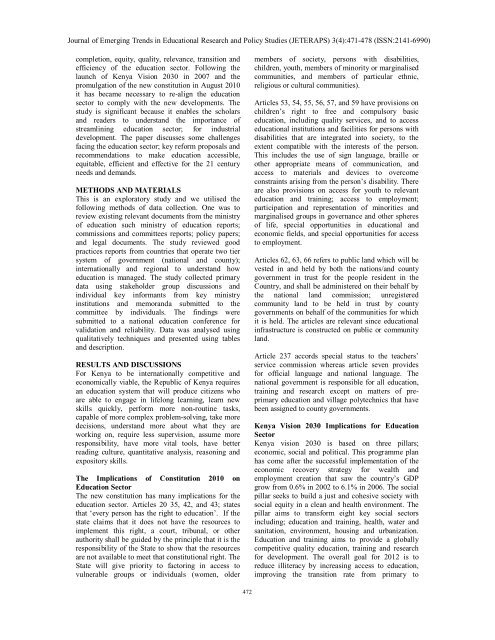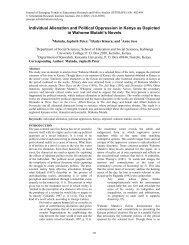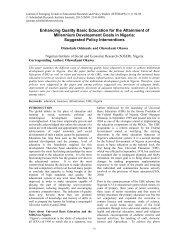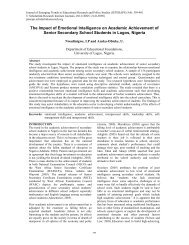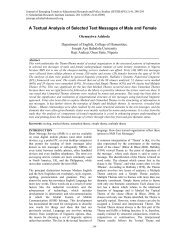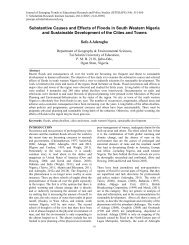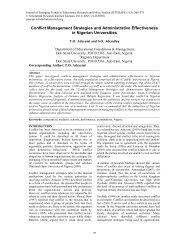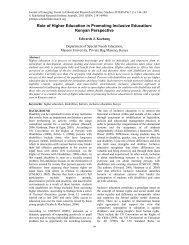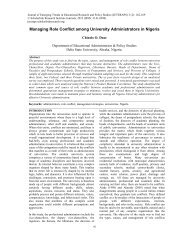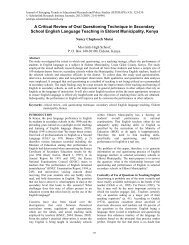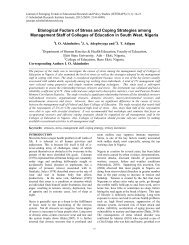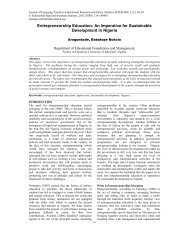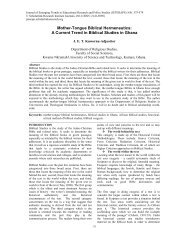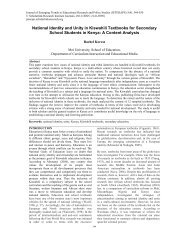Challenges and Reforms Facing Kenyan Education System in the ...
Challenges and Reforms Facing Kenyan Education System in the ...
Challenges and Reforms Facing Kenyan Education System in the ...
Create successful ePaper yourself
Turn your PDF publications into a flip-book with our unique Google optimized e-Paper software.
Journal of Emerg<strong>in</strong>g Trends <strong>in</strong> <strong>Education</strong>al Research <strong>and</strong> Policy Studies (JETERAPS) 3(4):471-478 (ISSN:2141-6990)<br />
completion, equity, quality, relevance, transition <strong>and</strong><br />
efficiency of <strong>the</strong> education sector. Follow<strong>in</strong>g <strong>the</strong><br />
launch of Kenya Vision 2030 <strong>in</strong> 2007 <strong>and</strong> <strong>the</strong><br />
promulgation of <strong>the</strong> new constitution <strong>in</strong> August 2010<br />
it has became necessary to re-align <strong>the</strong> education<br />
sector to comply with <strong>the</strong> new developments. The<br />
study is significant because it enables <strong>the</strong> scholars<br />
<strong>and</strong> readers to underst<strong>and</strong> <strong>the</strong> importance of<br />
streaml<strong>in</strong><strong>in</strong>g education sector; for <strong>in</strong>dustrial<br />
development. The paper discusses some challenges<br />
fac<strong>in</strong>g <strong>the</strong> education sector; key reform proposals <strong>and</strong><br />
recommendations to make education accessible,<br />
equitable, efficient <strong>and</strong> effective for <strong>the</strong> 21 century<br />
needs <strong>and</strong> dem<strong>and</strong>s.<br />
METHODS AND MATERIALS<br />
This is an exploratory study <strong>and</strong> we utilised <strong>the</strong><br />
follow<strong>in</strong>g methods of data collection. One was to<br />
review exist<strong>in</strong>g relevant documents from <strong>the</strong> m<strong>in</strong>istry<br />
of education such m<strong>in</strong>istry of education reports;<br />
commissions <strong>and</strong> committees reports; policy papers;<br />
<strong>and</strong> legal documents. The study reviewed good<br />
practices reports from countries that operate two tier<br />
system of government (national <strong>and</strong> county);<br />
<strong>in</strong>ternationally <strong>and</strong> regional to underst<strong>and</strong> how<br />
education is managed. The study collected primary<br />
data us<strong>in</strong>g stakeholder group discussions <strong>and</strong><br />
<strong>in</strong>dividual key <strong>in</strong>formants from key m<strong>in</strong>istry<br />
<strong>in</strong>stitutions <strong>and</strong> memor<strong>and</strong>a submitted to <strong>the</strong><br />
committee by <strong>in</strong>dividuals. The f<strong>in</strong>d<strong>in</strong>gs were<br />
submitted to a national education conference for<br />
validation <strong>and</strong> reliability. Data was analysed us<strong>in</strong>g<br />
qualitatively techniques <strong>and</strong> presented us<strong>in</strong>g tables<br />
<strong>and</strong> description.<br />
RESULTS AND DISCUSSIONS<br />
For Kenya to be <strong>in</strong>ternationally competitive <strong>and</strong><br />
economically viable, <strong>the</strong> Republic of Kenya requires<br />
an education system that will produce citizens who<br />
are able to engage <strong>in</strong> lifelong learn<strong>in</strong>g, learn new<br />
skills quickly, perform more non-rout<strong>in</strong>e tasks,<br />
capable of more complex problem-solv<strong>in</strong>g, take more<br />
decisions, underst<strong>and</strong> more about what <strong>the</strong>y are<br />
work<strong>in</strong>g on, require less supervision, assume more<br />
responsibility, have more vital tools, have better<br />
read<strong>in</strong>g culture, quantitative analysis, reason<strong>in</strong>g <strong>and</strong><br />
expository skills.<br />
The Implications of Constitution 2010 on<br />
<strong>Education</strong> Sector<br />
The new constitution has many implications for <strong>the</strong><br />
education sector. Articles 20 35, 42, <strong>and</strong> 43; states<br />
that ‘every person has <strong>the</strong> right to education’. If <strong>the</strong><br />
state claims that it does not have <strong>the</strong> resources to<br />
implement this right, a court, tribunal, or o<strong>the</strong>r<br />
authority shall be guided by <strong>the</strong> pr<strong>in</strong>ciple that it is <strong>the</strong><br />
responsibility of <strong>the</strong> State to show that <strong>the</strong> resources<br />
are not available to meet that constitutional right. The<br />
State will give priority to factor<strong>in</strong>g <strong>in</strong> access to<br />
vulnerable groups or <strong>in</strong>dividuals (women, older<br />
members of society, persons with disabilities,<br />
children, youth, members of m<strong>in</strong>ority or marg<strong>in</strong>alised<br />
communities, <strong>and</strong> members of particular ethnic,<br />
religious or cultural communities).<br />
Articles 53, 54, 55, 56, 57, <strong>and</strong> 59 have provisions on<br />
children’s right to free <strong>and</strong> compulsory basic<br />
education, <strong>in</strong>clud<strong>in</strong>g quality services, <strong>and</strong> to access<br />
educational <strong>in</strong>stitutions <strong>and</strong> facilities for persons with<br />
disabilities that are <strong>in</strong>tegrated <strong>in</strong>to society, to <strong>the</strong><br />
extent compatible with <strong>the</strong> <strong>in</strong>terests of <strong>the</strong> person.<br />
This <strong>in</strong>cludes <strong>the</strong> use of sign language, braille or<br />
o<strong>the</strong>r appropriate means of communication, <strong>and</strong><br />
access to materials <strong>and</strong> devices to overcome<br />
constra<strong>in</strong>ts aris<strong>in</strong>g from <strong>the</strong> person’s disability. There<br />
are also provisions on access for youth to relevant<br />
education <strong>and</strong> tra<strong>in</strong><strong>in</strong>g; access to employment;<br />
participation <strong>and</strong> representation of m<strong>in</strong>orities <strong>and</strong><br />
marg<strong>in</strong>alised groups <strong>in</strong> governance <strong>and</strong> o<strong>the</strong>r spheres<br />
of life, special opportunities <strong>in</strong> educational <strong>and</strong><br />
economic fields, <strong>and</strong> special opportunities for access<br />
to employment.<br />
Articles 62, 63, 66 refers to public l<strong>and</strong> which will be<br />
vested <strong>in</strong> <strong>and</strong> held by both <strong>the</strong> nations/<strong>and</strong> county<br />
government <strong>in</strong> trust for <strong>the</strong> people resident <strong>in</strong> <strong>the</strong><br />
Country, <strong>and</strong> shall be adm<strong>in</strong>istered on <strong>the</strong>ir behalf by<br />
<strong>the</strong> national l<strong>and</strong> commission; unregistered<br />
community l<strong>and</strong> to be held <strong>in</strong> trust by county<br />
governments on behalf of <strong>the</strong> communities for which<br />
it is held. The articles are relevant s<strong>in</strong>ce educational<br />
<strong>in</strong>frastructure is constructed on public or community<br />
l<strong>and</strong>.<br />
Article 237 accords special status to <strong>the</strong> teachers’<br />
service commission whereas article seven provides<br />
for official language <strong>and</strong> national language. The<br />
national government is responsible for all education,<br />
tra<strong>in</strong><strong>in</strong>g <strong>and</strong> research except on matters of preprimary<br />
education <strong>and</strong> village polytechnics that have<br />
been assigned to county governments.<br />
Kenya Vision 2030 Implications for <strong>Education</strong><br />
Sector<br />
Kenya vision 2030 is based on three pillars;<br />
economic, social <strong>and</strong> political. This programme plan<br />
has come after <strong>the</strong> successful implementation of <strong>the</strong><br />
economic recovery strategy for wealth <strong>and</strong><br />
employment creation that saw <strong>the</strong> country’s GDP<br />
grow from 0.6% <strong>in</strong> 2002 to 6.1% <strong>in</strong> 2006. The social<br />
pillar seeks to build a just <strong>and</strong> cohesive society with<br />
social equity <strong>in</strong> a clean <strong>and</strong> health environment. The<br />
pillar aims to transform eight key social sectors<br />
<strong>in</strong>clud<strong>in</strong>g; education <strong>and</strong> tra<strong>in</strong><strong>in</strong>g, health, water <strong>and</strong><br />
sanitation, environment, hous<strong>in</strong>g <strong>and</strong> urbanization.<br />
<strong>Education</strong> <strong>and</strong> tra<strong>in</strong><strong>in</strong>g aims to provide a globally<br />
competitive quality education, tra<strong>in</strong><strong>in</strong>g <strong>and</strong> research<br />
for development. The overall goal for 2012 is to<br />
reduce illiteracy by <strong>in</strong>creas<strong>in</strong>g access to education,<br />
improv<strong>in</strong>g <strong>the</strong> transition rate from primary to<br />
472


